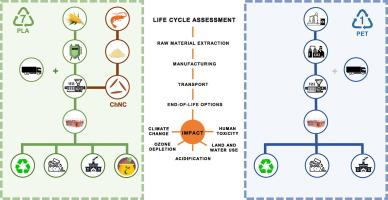甲壳素纳米晶增强聚乳酸(ChNC/PLA)和聚对苯二甲酸乙二醇酯(PET)包装材料的生命周期评估(LCA)
IF 10.7
1区 化学
Q1 CHEMISTRY, APPLIED
引用次数: 0
摘要
生物纳米复合材料有望降低塑料材料对环境的影响,并减少对化石基塑料等不可再生资源的依赖。在这项研究中,我们提出了甲壳素纳米晶(ChNC)增强聚乳酸(PLA)作为可生物降解的聚合物,其天然来源的纳米粒子可增强基础聚合物的强度。迄今为止,这些生物纳米复合材料已从基础和实用角度进行了评估,但对其环境影响的深入研究仍然有限。我们对 ChNC 的规模化生产(包括将其加入聚乳酸)进行了生命周期评估(LCA)。我们使用十项影响指标将其与基准聚对苯二甲酸乙二醇酯(PET)进行比较,主要关注气候变化。对于聚乳酸、聚对苯二甲酸乙二醇酯和 ChNC/聚乳酸(5% 颗粒),生产过程分别产生了 3.04、3.21 和 4.26 千克二氧化碳当量。回收工艺大大提高了塑料的可持续发展能力,但在实际应用中仍面临挑战。在这方面,可堆肥聚乳酸和 ChNC/PLA 材料优于最终被填埋的传统塑料。与目前的实验室条件相比,通过减少酸水解过程中的盐酸和水用量以及干燥过程中的能源用量,可将 ChNC 生产对气候变化的影响降低 30% 至 40%。将这些见解纳入 ChNC/PLA 的生产和后期使用策略中,可指导生物纳米复合材料的生产朝着更可持续的方向发展。本文章由计算机程序翻译,如有差异,请以英文原文为准。

Life cycle assessment (LCA) of chitin nanocrystal reinforced polylactic acid (ChNC/PLA) and polyethylene terephthalate (PET) packaging material
Bio-nanocomposites hold the promise to reduce environmental impact of plastic materials and lessen reliance on non-renewable resources as is the case for fossil-based plastics. In this study, we present chitin nanocrystal (ChNC) reinforced polylactic acid (PLA) as biodegradable polymer with natural-origin nanoparticles, enhancing the base polymer's strength. Until now, these bio-nanocomposites have been evaluated from fundamental and practical perspectives, yet, in-depth research on their environmental impact remains limited. We conducted a life cycle assessment (LCA) for upscaled ChNC production including its incorporation into PLA. We compare with the benchmark polyethylene terephthalate (PET) using ten impact indicators, primarily focusing on climate change. For PLA, PET, and ChNC/PLA (5 % particles), the production processes resulted in 3.04, 3.21, and 4.26 kg CO2 equivalent, respectively. Recycling processes greatly enhance plastics sustainability, though practical implementation remains challenging. On that aspect, compostable PLA and ChNC/PLA materials outperform conventional plastics that end up in landfill. The climate change impact of ChNC production can be reduced by 30 to 40 % by decreasing HCl and water use during acid hydrolysis and energy used during drying compared to current laboratory conditions. These insights incorporated into ChNC/PLA production and post-use strategies can guide bio-nanocomposite production toward more sustainable practices.
求助全文
通过发布文献求助,成功后即可免费获取论文全文。
去求助
来源期刊

Carbohydrate Polymers
化学-高分子科学
CiteScore
22.40
自引率
8.00%
发文量
1286
审稿时长
47 days
期刊介绍:
Carbohydrate Polymers stands as a prominent journal in the glycoscience field, dedicated to exploring and harnessing the potential of polysaccharides with applications spanning bioenergy, bioplastics, biomaterials, biorefining, chemistry, drug delivery, food, health, nanotechnology, packaging, paper, pharmaceuticals, medicine, oil recovery, textiles, tissue engineering, wood, and various aspects of glycoscience.
The journal emphasizes the central role of well-characterized carbohydrate polymers, highlighting their significance as the primary focus rather than a peripheral topic. Each paper must prominently feature at least one named carbohydrate polymer, evident in both citation and title, with a commitment to innovative research that advances scientific knowledge.
 求助内容:
求助内容: 应助结果提醒方式:
应助结果提醒方式:


